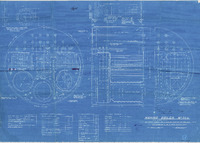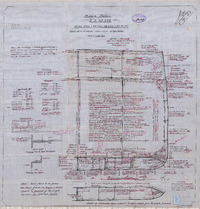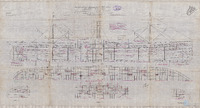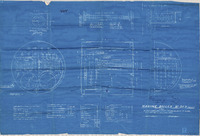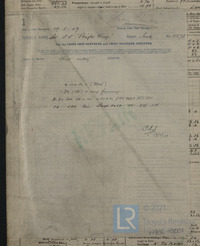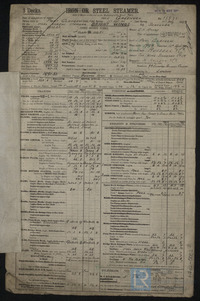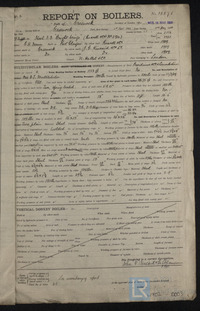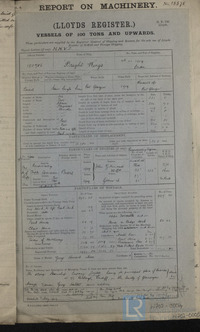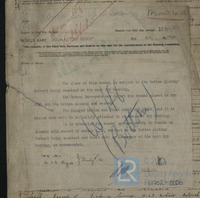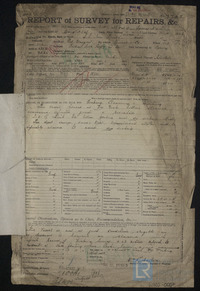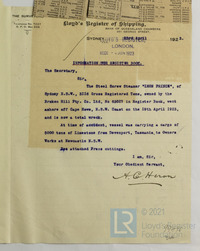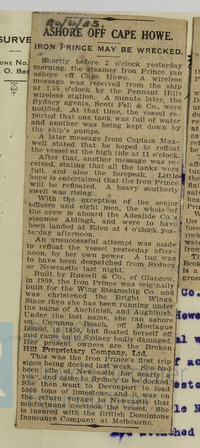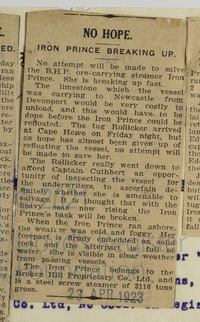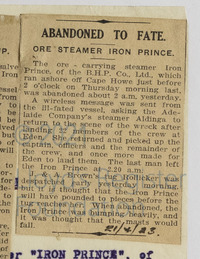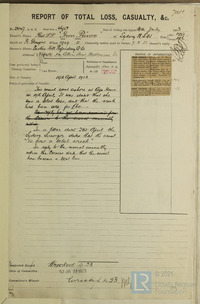- Related documents Related
- Complete documents list Documents
- Report ship? Report?
Use the data export button to extract customised data sets from the Ship Plan and Survey Report Collection. Available in TSV and CSV formats.
Name of ship as recorded on the record
Ship name
Bright Wings ( Plan of Marine Boiler for Bright Wings, 16th September 1908 1908, Half Midship Section Plan for Bright Wings, 7th September 1908 1908, Longitudinal Section & Deck Plans for Bright Wings, 7th September 1908 1908, Plan of Marine Boiler for Bright Wings, 16th September 1908 1908, Memo to the Chief Ship Surveyor & Chief Engineer Surveyor regarding First Entry for Bright Wings, 19th May 1909 1909, Steel Steamer Report for Bright Wings, 11th May 1909 1909, Report on Boilers for Bright Wings, 11th May 1909 1909, Form for Vessels of 100 Tons & Upwards for Bright Wings, 12th May 1909 1909, Report on Machinery for Bright Wings, 13th May 1909 1909, Correspondence from the General Manager of The Broken Hill Proprietary Co Ltd to Lloyds Register London regarding Iron Prince, 16 June 1923 1923, Correspondence from A C Heron to the Secretary of Lloyds Register London regarding the wrecking of Iron Prince, 23 April 1923 1923, Newspaper clipping regarding the wrecking of Iron Prince, 20 April 1923 1923, Newspaper clipping regarding the breaking up of Iron Prince, 23 April 1923 1923, Newspaper clipping regarding the loss of Iron Prince, 23 April 1923 1923, Report of Total Loss and Casualty for Iron Prince, 30 July 1923 1923 )
Iron Prince ( Remarks of the Chief Ship Surveyor to the Classing Committee regarding the dry docking of Iron Prince, 22nd May 1923 1923, Report of Survey for Repairs, &c for Iron Prince, 13th April 1923 1923 )
The process of transferring a vessel to water, but not necessarily her completion.
Launch Date
22/04/1909 ( Plan of Marine Boiler for Bright Wings, 16th September 1908 1908, Half Midship Section Plan for Bright Wings, 7th September 1908 1908, Longitudinal Section & Deck Plans for Bright Wings, 7th September 1908 1908, Plan of Marine Boiler for Bright Wings, 16th September 1908 1908, Memo to the Chief Ship Surveyor & Chief Engineer Surveyor regarding First Entry for Bright Wings, 19th May 1909 1909, Steel Steamer Report for Bright Wings, 11th May 1909 1909, Report on Boilers for Bright Wings, 11th May 1909 1909, Form for Vessels of 100 Tons & Upwards for Bright Wings, 12th May 1909 1909, Report on Machinery for Bright Wings, 13th May 1909 1909, Remarks of the Chief Ship Surveyor to the Classing Committee regarding the dry docking of Iron Prince, 22nd May 1923 1923, Report of Survey for Repairs, &c for Iron Prince, 13th April 1923 1923, Correspondence from the General Manager of The Broken Hill Proprietary Co Ltd to Lloyds Register London regarding Iron Prince, 16 June 1923 1923, Correspondence from A C Heron to the Secretary of Lloyds Register London regarding the wrecking of Iron Prince, 23 April 1923 1923, Newspaper clipping regarding the wrecking of Iron Prince, 20 April 1923 1923, Newspaper clipping regarding the breaking up of Iron Prince, 23 April 1923 1923, Newspaper clipping regarding the loss of Iron Prince, 23 April 1923 1923, Report of Total Loss and Casualty for Iron Prince, 30 July 1923 1923 )
Unique identifier for a given ship, it is assigned by a builder.
Yard no
594 ( Plan of Marine Boiler for Bright Wings, 16th September 1908 1908, Half Midship Section Plan for Bright Wings, 7th September 1908 1908, Longitudinal Section & Deck Plans for Bright Wings, 7th September 1908 1908, Plan of Marine Boiler for Bright Wings, 16th September 1908 1908, Memo to the Chief Ship Surveyor & Chief Engineer Surveyor regarding First Entry for Bright Wings, 19th May 1909 1909, Steel Steamer Report for Bright Wings, 11th May 1909 1909, Report on Boilers for Bright Wings, 11th May 1909 1909, Form for Vessels of 100 Tons & Upwards for Bright Wings, 12th May 1909 1909, Report on Machinery for Bright Wings, 13th May 1909 1909, Remarks of the Chief Ship Surveyor to the Classing Committee regarding the dry docking of Iron Prince, 22nd May 1923 1923, Report of Survey for Repairs, &c for Iron Prince, 13th April 1923 1923, Correspondence from the General Manager of The Broken Hill Proprietary Co Ltd to Lloyds Register London regarding Iron Prince, 16 June 1923 1923, Correspondence from A C Heron to the Secretary of Lloyds Register London regarding the wrecking of Iron Prince, 23 April 1923 1923, Newspaper clipping regarding the wrecking of Iron Prince, 20 April 1923 1923, Newspaper clipping regarding the breaking up of Iron Prince, 23 April 1923 1923, Newspaper clipping regarding the loss of Iron Prince, 23 April 1923 1923, Report of Total Loss and Casualty for Iron Prince, 30 July 1923 1923 )
The port or place in which the vessel’s construction took place, at the time of writing.
Place of build
Port Glasgow ( Plan of Marine Boiler for Bright Wings, 16th September 1908 1908, Half Midship Section Plan for Bright Wings, 7th September 1908 1908, Longitudinal Section & Deck Plans for Bright Wings, 7th September 1908 1908, Plan of Marine Boiler for Bright Wings, 16th September 1908 1908, Memo to the Chief Ship Surveyor & Chief Engineer Surveyor regarding First Entry for Bright Wings, 19th May 1909 1909, Steel Steamer Report for Bright Wings, 11th May 1909 1909, Report on Boilers for Bright Wings, 11th May 1909 1909, Form for Vessels of 100 Tons & Upwards for Bright Wings, 12th May 1909 1909, Report on Machinery for Bright Wings, 13th May 1909 1909, Remarks of the Chief Ship Surveyor to the Classing Committee regarding the dry docking of Iron Prince, 22nd May 1923 1923, Report of Survey for Repairs, &c for Iron Prince, 13th April 1923 1923, Correspondence from the General Manager of The Broken Hill Proprietary Co Ltd to Lloyds Register London regarding Iron Prince, 16 June 1923 1923, Correspondence from A C Heron to the Secretary of Lloyds Register London regarding the wrecking of Iron Prince, 23 April 1923 1923, Newspaper clipping regarding the wrecking of Iron Prince, 20 April 1923 1923, Newspaper clipping regarding the breaking up of Iron Prince, 23 April 1923 1923, Newspaper clipping regarding the loss of Iron Prince, 23 April 1923 1923, Report of Total Loss and Casualty for Iron Prince, 30 July 1923 1923 )
Broad categories and subdivisions of vessels related to their purpose or function.
Ship type
undefined ( Plan of Marine Boiler for Bright Wings, 16th September 1908 1908, Half Midship Section Plan for Bright Wings, 7th September 1908 1908, Longitudinal Section & Deck Plans for Bright Wings, 7th September 1908 1908, Plan of Marine Boiler for Bright Wings, 16th September 1908 1908, Memo to the Chief Ship Surveyor & Chief Engineer Surveyor regarding First Entry for Bright Wings, 19th May 1909 1909, Report on Boilers for Bright Wings, 11th May 1909 1909, Report on Machinery for Bright Wings, 13th May 1909 1909, Remarks of the Chief Ship Surveyor to the Classing Committee regarding the dry docking of Iron Prince, 22nd May 1923 1923, Report of Survey for Repairs, &c for Iron Prince, 13th April 1923 1923, Correspondence from the General Manager of The Broken Hill Proprietary Co Ltd to Lloyds Register London regarding Iron Prince, 16 June 1923 1923, Correspondence from A C Heron to the Secretary of Lloyds Register London regarding the wrecking of Iron Prince, 23 April 1923 1923, Newspaper clipping regarding the wrecking of Iron Prince, 20 April 1923 1923, Newspaper clipping regarding the breaking up of Iron Prince, 23 April 1923 1923, Newspaper clipping regarding the loss of Iron Prince, 23 April 1923 1923, Report of Total Loss and Casualty for Iron Prince, 30 July 1923 1923 )
Screw Steamer ( Steel Steamer Report for Bright Wings, 11th May 1909 1909, Form for Vessels of 100 Tons & Upwards for Bright Wings, 12th May 1909 1909 )
Predominant material(s) utilised in a vessel’s construction.
Material of construction
Steel ( Plan of Marine Boiler for Bright Wings, 16th September 1908 1908, Half Midship Section Plan for Bright Wings, 7th September 1908 1908, Longitudinal Section & Deck Plans for Bright Wings, 7th September 1908 1908, Plan of Marine Boiler for Bright Wings, 16th September 1908 1908, Memo to the Chief Ship Surveyor & Chief Engineer Surveyor regarding First Entry for Bright Wings, 19th May 1909 1909, Steel Steamer Report for Bright Wings, 11th May 1909 1909, Report on Boilers for Bright Wings, 11th May 1909 1909, Form for Vessels of 100 Tons & Upwards for Bright Wings, 12th May 1909 1909, Report on Machinery for Bright Wings, 13th May 1909 1909, Remarks of the Chief Ship Surveyor to the Classing Committee regarding the dry docking of Iron Prince, 22nd May 1923 1923, Report of Survey for Repairs, &c for Iron Prince, 13th April 1923 1923 )
Confirmation as to whether the vessel was equipped with refrigeration machinery to aid in the transport of frozen or chilled cargo/goods.
Refrigeration machinery fitted for cargo purposes?
No ( Plan of Marine Boiler for Bright Wings, 16th September 1908 1908, Half Midship Section Plan for Bright Wings, 7th September 1908 1908, Longitudinal Section & Deck Plans for Bright Wings, 7th September 1908 1908, Plan of Marine Boiler for Bright Wings, 16th September 1908 1908, Memo to the Chief Ship Surveyor & Chief Engineer Surveyor regarding First Entry for Bright Wings, 19th May 1909 1909, Steel Steamer Report for Bright Wings, 11th May 1909 1909, Report on Boilers for Bright Wings, 11th May 1909 1909, Form for Vessels of 100 Tons & Upwards for Bright Wings, 12th May 1909 1909, Report on Machinery for Bright Wings, 13th May 1909 1909, Remarks of the Chief Ship Surveyor to the Classing Committee regarding the dry docking of Iron Prince, 22nd May 1923 1923, Report of Survey for Repairs, &c for Iron Prince, 13th April 1923 1923, Correspondence from the General Manager of The Broken Hill Proprietary Co Ltd to Lloyds Register London regarding Iron Prince, 16 June 1923 1923, Correspondence from A C Heron to the Secretary of Lloyds Register London regarding the wrecking of Iron Prince, 23 April 1923 1923, Newspaper clipping regarding the wrecking of Iron Prince, 20 April 1923 1923, Newspaper clipping regarding the breaking up of Iron Prince, 23 April 1923 1923, Newspaper clipping regarding the loss of Iron Prince, 23 April 1923 1923, Report of Total Loss and Casualty for Iron Prince, 30 July 1923 1923 )
Does the vessel possess an auxiliary power source?
Auxillary
No ( Plan of Marine Boiler for Bright Wings, 16th September 1908 1908, Half Midship Section Plan for Bright Wings, 7th September 1908 1908, Longitudinal Section & Deck Plans for Bright Wings, 7th September 1908 1908, Plan of Marine Boiler for Bright Wings, 16th September 1908 1908, Memo to the Chief Ship Surveyor & Chief Engineer Surveyor regarding First Entry for Bright Wings, 19th May 1909 1909, Steel Steamer Report for Bright Wings, 11th May 1909 1909, Report on Boilers for Bright Wings, 11th May 1909 1909, Form for Vessels of 100 Tons & Upwards for Bright Wings, 12th May 1909 1909, Report on Machinery for Bright Wings, 13th May 1909 1909, Remarks of the Chief Ship Surveyor to the Classing Committee regarding the dry docking of Iron Prince, 22nd May 1923 1923, Report of Survey for Repairs, &c for Iron Prince, 13th April 1923 1923, Correspondence from the General Manager of The Broken Hill Proprietary Co Ltd to Lloyds Register London regarding Iron Prince, 16 June 1923 1923, Correspondence from A C Heron to the Secretary of Lloyds Register London regarding the wrecking of Iron Prince, 23 April 1923 1923, Newspaper clipping regarding the wrecking of Iron Prince, 20 April 1923 1923, Newspaper clipping regarding the breaking up of Iron Prince, 23 April 1923 1923, Newspaper clipping regarding the loss of Iron Prince, 23 April 1923 1923, Report of Total Loss and Casualty for Iron Prince, 30 July 1923 1923 )
Is electric lighting fitted to the vessel?
Electric light fitted?
No ( Plan of Marine Boiler for Bright Wings, 16th September 1908 1908, Half Midship Section Plan for Bright Wings, 7th September 1908 1908, Longitudinal Section & Deck Plans for Bright Wings, 7th September 1908 1908, Plan of Marine Boiler for Bright Wings, 16th September 1908 1908, Memo to the Chief Ship Surveyor & Chief Engineer Surveyor regarding First Entry for Bright Wings, 19th May 1909 1909, Steel Steamer Report for Bright Wings, 11th May 1909 1909, Report on Boilers for Bright Wings, 11th May 1909 1909, Form for Vessels of 100 Tons & Upwards for Bright Wings, 12th May 1909 1909, Report on Machinery for Bright Wings, 13th May 1909 1909, Remarks of the Chief Ship Surveyor to the Classing Committee regarding the dry docking of Iron Prince, 22nd May 1923 1923, Report of Survey for Repairs, &c for Iron Prince, 13th April 1923 1923, Correspondence from the General Manager of The Broken Hill Proprietary Co Ltd to Lloyds Register London regarding Iron Prince, 16 June 1923 1923, Correspondence from A C Heron to the Secretary of Lloyds Register London regarding the wrecking of Iron Prince, 23 April 1923 1923, Newspaper clipping regarding the wrecking of Iron Prince, 20 April 1923 1923, Newspaper clipping regarding the breaking up of Iron Prince, 23 April 1923 1923, Newspaper clipping regarding the loss of Iron Prince, 23 April 1923 1923, Report of Total Loss and Casualty for Iron Prince, 30 July 1923 1923 )
Abbreviations of the names of ports with Lloyd’s Register survey offices.
The individual and/or organisation listed
Ship owner
The Wing Steamship Co Ltd ( Steel Steamer Report for Bright Wings, 11th May 1909 1909, Form for Vessels of 100 Tons & Upwards for Bright Wings, 12th May 1909 1909 )
N Hallet & Co ( Report on Boilers for Bright Wings, 11th May 1909 1909, Report on Machinery for Bright Wings, 13th May 1909 1909 )
Broken Hill Property Co Ltd ( Report of Survey for Repairs, &c for Iron Prince, 13th April 1923 1923 )
Broken Hill Proprietary Co Ld ( Newspaper clipping regarding the breaking up of Iron Prince, 23 April 1923 1923, Report of Total Loss and Casualty for Iron Prince, 30 July 1923 1923 )
An officially licensed mariner (post 1850) holding ultimate command and responsibility for a vessel.
Classification symbol assigned to a vessel by Lloyd’s Register’s Classing Committee denoting the quality of construction and maintenance.
Classification
+100A1; (Steel) 5,09; Lloyd's A & CP; +LMC 5,09 ( Steel Steamer Report for Bright Wings, 11th May 1909 1909 )
See Minute on Accompanying Report ( Report on Boilers for Bright Wings, 11th May 1909 1909 )
+LMC 5,09 ( Report on Machinery for Bright Wings, 13th May 1909 1909 )
+100A1; BS 4,23 ( Report of Survey for Repairs, &c for Iron Prince, 13th April 1923 1923 )
+100A1 4.23 ( Report of Total Loss and Casualty for Iron Prince, 30 July 1923 1923 )
The name of the port/place of destination given.
Destined voyage
Buenos Ayres ( Steel Steamer Report for Bright Wings, 11th May 1909 1909 )
Interstole ( Report of Survey for Repairs, &c for Iron Prince, 13th April 1923 1923 )
Owners works at Newcastle, New South Wales ( Correspondence from A C Heron to the Secretary of Lloyds Register London regarding the wrecking of Iron Prince, 23 April 1923 1923, Newspaper clipping regarding the breaking up of Iron Prince, 23 April 1923 1923 )
Newcastle, New South Wales ( Report of Total Loss and Casualty for Iron Prince, 30 July 1923 1923 )
A ship’s total internal volume in ‘register tons’ (replaced by gross tonnage post 1982).
Gross Register Tonnage
3116 ( Steel Steamer Report for Bright Wings, 11th May 1909 1909, Report on Boilers for Bright Wings, 11th May 1909 1909, Form for Vessels of 100 Tons & Upwards for Bright Wings, 12th May 1909 1909, Report on Machinery for Bright Wings, 13th May 1909 1909, Report of Survey for Repairs, &c for Iron Prince, 13th April 1923 1923 )
Date in which construction of a vessel’s engines were completed.
The port in which a vessel is registered or permanently based.
Port of registry
London ( Form for Vessels of 100 Tons & Upwards for Bright Wings, 12th May 1909 1909 )
The name of the port/place from which a vessel’s voyage originated.
Voyage from
Devonport, Tasmania ( Correspondence from A C Heron to the Secretary of Lloyds Register London regarding the wrecking of Iron Prince, 23 April 1923 1923 )
System of measurement that replaced ‘Builder’s Old Measurement’, taking a vessel’s internal capacity as the standard. Vessels built between 1836 and 1854 were legally required to display both tonnages.
Gross Register Tonnage (NM)
3116 ( Newspaper clipping regarding the breaking up of Iron Prince, 23 April 1923 1923, Report of Total Loss and Casualty for Iron Prince, 30 July 1923 1923 )
Used to indicate the capability of early reciprocating steam engines, based on dimensions rather than performance. It is not a true indication of actual engine power.
Horsepower nominal
276 ( Report of Total Loss and Casualty for Iron Prince, 30 July 1923 1923 )
The year in which a vessel’s construction is completed.
Year of ship completion
1909 ( Plan of Marine Boiler for Bright Wings, 16th September 1908 1908, Half Midship Section Plan for Bright Wings, 7th September 1908 1908, Longitudinal Section & Deck Plans for Bright Wings, 7th September 1908 1908, Plan of Marine Boiler for Bright Wings, 16th September 1908 1908, Memo to the Chief Ship Surveyor & Chief Engineer Surveyor regarding First Entry for Bright Wings, 19th May 1909 1909, Steel Steamer Report for Bright Wings, 11th May 1909 1909, Report on Boilers for Bright Wings, 11th May 1909 1909, Form for Vessels of 100 Tons & Upwards for Bright Wings, 12th May 1909 1909, Report on Machinery for Bright Wings, 13th May 1909 1909, Remarks of the Chief Ship Surveyor to the Classing Committee regarding the dry docking of Iron Prince, 22nd May 1923 1923, Report of Survey for Repairs, &c for Iron Prince, 13th April 1923 1923, Correspondence from the General Manager of The Broken Hill Proprietary Co Ltd to Lloyds Register London regarding Iron Prince, 16 June 1923 1923, Correspondence from A C Heron to the Secretary of Lloyds Register London regarding the wrecking of Iron Prince, 23 April 1923 1923, Newspaper clipping regarding the wrecking of Iron Prince, 20 April 1923 1923, Newspaper clipping regarding the breaking up of Iron Prince, 23 April 1923 1923, Newspaper clipping regarding the loss of Iron Prince, 23 April 1923 1923, Report of Total Loss and Casualty for Iron Prince, 30 July 1923 1923 )
The individual and/or organisation listed as having been responsible for constructing the vessel. This can/may be the same as the owner and/or manager.
Shipbuilder
Russell & Co ( Plan of Marine Boiler for Bright Wings, 16th September 1908 1908, Half Midship Section Plan for Bright Wings, 7th September 1908 1908, Longitudinal Section & Deck Plans for Bright Wings, 7th September 1908 1908, Plan of Marine Boiler for Bright Wings, 16th September 1908 1908, Memo to the Chief Ship Surveyor & Chief Engineer Surveyor regarding First Entry for Bright Wings, 19th May 1909 1909, Steel Steamer Report for Bright Wings, 11th May 1909 1909, Report on Boilers for Bright Wings, 11th May 1909 1909, Form for Vessels of 100 Tons & Upwards for Bright Wings, 12th May 1909 1909, Report on Machinery for Bright Wings, 13th May 1909 1909, Remarks of the Chief Ship Surveyor to the Classing Committee regarding the dry docking of Iron Prince, 22nd May 1923 1923, Report of Survey for Repairs, &c for Iron Prince, 13th April 1923 1923, Correspondence from the General Manager of The Broken Hill Proprietary Co Ltd to Lloyds Register London regarding Iron Prince, 16 June 1923 1923, Correspondence from A C Heron to the Secretary of Lloyds Register London regarding the wrecking of Iron Prince, 23 April 1923 1923, Newspaper clipping regarding the wrecking of Iron Prince, 20 April 1923 1923, Newspaper clipping regarding the breaking up of Iron Prince, 23 April 1923 1923, Newspaper clipping regarding the loss of Iron Prince, 23 April 1923 1923, Report of Total Loss and Casualty for Iron Prince, 30 July 1923 1923 )
The name of the yard where the vessel was built.
Yard name
Kingston Yard ( Plan of Marine Boiler for Bright Wings, 16th September 1908 1908, Half Midship Section Plan for Bright Wings, 7th September 1908 1908, Longitudinal Section & Deck Plans for Bright Wings, 7th September 1908 1908, Plan of Marine Boiler for Bright Wings, 16th September 1908 1908, Memo to the Chief Ship Surveyor & Chief Engineer Surveyor regarding First Entry for Bright Wings, 19th May 1909 1909, Steel Steamer Report for Bright Wings, 11th May 1909 1909, Report on Boilers for Bright Wings, 11th May 1909 1909, Form for Vessels of 100 Tons & Upwards for Bright Wings, 12th May 1909 1909, Report on Machinery for Bright Wings, 13th May 1909 1909, Remarks of the Chief Ship Surveyor to the Classing Committee regarding the dry docking of Iron Prince, 22nd May 1923 1923, Report of Survey for Repairs, &c for Iron Prince, 13th April 1923 1923, Correspondence from the General Manager of The Broken Hill Proprietary Co Ltd to Lloyds Register London regarding Iron Prince, 16 June 1923 1923, Correspondence from A C Heron to the Secretary of Lloyds Register London regarding the wrecking of Iron Prince, 23 April 1923 1923, Newspaper clipping regarding the wrecking of Iron Prince, 20 April 1923 1923, Newspaper clipping regarding the breaking up of Iron Prince, 23 April 1923 1923, Newspaper clipping regarding the loss of Iron Prince, 23 April 1923 1923, Report of Total Loss and Casualty for Iron Prince, 30 July 1923 1923 )
Location where a vessel’s survey was undertaken.
Location of Survey
Greenock ( Plan of Marine Boiler for Bright Wings, 16th September 1908 1908, Plan of Marine Boiler for Bright Wings, 16th September 1908 1908, Report on Boilers for Bright Wings, 11th May 1909 1909, Report on Machinery for Bright Wings, 13th May 1909 1909 )
Port Glasgow ( Half Midship Section Plan for Bright Wings, 7th September 1908 1908, Longitudinal Section & Deck Plans for Bright Wings, 7th September 1908 1908 )
Port Glasgow; Greenock ( Steel Steamer Report for Bright Wings, 11th May 1909 1909 )
London ( Form for Vessels of 100 Tons & Upwards for Bright Wings, 12th May 1909 1909 )
Sydney N S W ( Report of Survey for Repairs, &c for Iron Prince, 13th April 1923 1923 )
320 Collins Street, Melbourne ( Correspondence from the General Manager of The Broken Hill Proprietary Co Ltd to Lloyds Register London regarding Iron Prince, 16 June 1923 1923 )
Bank of Queensland Chambers, 251 George Street, Sydney ( Correspondence from A C Heron to the Secretary of Lloyds Register London regarding the wrecking of Iron Prince, 23 April 1923 1923 )
A vessel’s means of propulsion.
Propulsion
Steam ( Plan of Marine Boiler for Bright Wings, 16th September 1908 1908, Half Midship Section Plan for Bright Wings, 7th September 1908 1908, Longitudinal Section & Deck Plans for Bright Wings, 7th September 1908 1908, Plan of Marine Boiler for Bright Wings, 16th September 1908 1908, Memo to the Chief Ship Surveyor & Chief Engineer Surveyor regarding First Entry for Bright Wings, 19th May 1909 1909, Steel Steamer Report for Bright Wings, 11th May 1909 1909, Report on Boilers for Bright Wings, 11th May 1909 1909, Form for Vessels of 100 Tons & Upwards for Bright Wings, 12th May 1909 1909, Report on Machinery for Bright Wings, 13th May 1909 1909, Remarks of the Chief Ship Surveyor to the Classing Committee regarding the dry docking of Iron Prince, 22nd May 1923 1923, Report of Survey for Repairs, &c for Iron Prince, 13th April 1923 1923, Correspondence from the General Manager of The Broken Hill Proprietary Co Ltd to Lloyds Register London regarding Iron Prince, 16 June 1923 1923, Correspondence from A C Heron to the Secretary of Lloyds Register London regarding the wrecking of Iron Prince, 23 April 1923 1923, Newspaper clipping regarding the wrecking of Iron Prince, 20 April 1923 1923, Newspaper clipping regarding the breaking up of Iron Prince, 23 April 1923 1923, Newspaper clipping regarding the loss of Iron Prince, 23 April 1923 1923, Report of Total Loss and Casualty for Iron Prince, 30 July 1923 1923 )
Is the steamer assisted by sail?
Sail assisted steamer
No ( Plan of Marine Boiler for Bright Wings, 16th September 1908 1908, Half Midship Section Plan for Bright Wings, 7th September 1908 1908, Longitudinal Section & Deck Plans for Bright Wings, 7th September 1908 1908, Plan of Marine Boiler for Bright Wings, 16th September 1908 1908, Memo to the Chief Ship Surveyor & Chief Engineer Surveyor regarding First Entry for Bright Wings, 19th May 1909 1909, Steel Steamer Report for Bright Wings, 11th May 1909 1909, Report on Boilers for Bright Wings, 11th May 1909 1909, Form for Vessels of 100 Tons & Upwards for Bright Wings, 12th May 1909 1909, Report on Machinery for Bright Wings, 13th May 1909 1909, Remarks of the Chief Ship Surveyor to the Classing Committee regarding the dry docking of Iron Prince, 22nd May 1923 1923, Report of Survey for Repairs, &c for Iron Prince, 13th April 1923 1923, Correspondence from the General Manager of The Broken Hill Proprietary Co Ltd to Lloyds Register London regarding Iron Prince, 16 June 1923 1923, Correspondence from A C Heron to the Secretary of Lloyds Register London regarding the wrecking of Iron Prince, 23 April 1923 1923, Newspaper clipping regarding the wrecking of Iron Prince, 20 April 1923 1923, Newspaper clipping regarding the breaking up of Iron Prince, 23 April 1923 1923, Newspaper clipping regarding the loss of Iron Prince, 23 April 1923 1923, Report of Total Loss and Casualty for Iron Prince, 30 July 1923 1923 )
Is machinery fitted at the aft of the vessel?
Machinery aft?
No ( Plan of Marine Boiler for Bright Wings, 16th September 1908 1908, Half Midship Section Plan for Bright Wings, 7th September 1908 1908, Longitudinal Section & Deck Plans for Bright Wings, 7th September 1908 1908, Plan of Marine Boiler for Bright Wings, 16th September 1908 1908, Memo to the Chief Ship Surveyor & Chief Engineer Surveyor regarding First Entry for Bright Wings, 19th May 1909 1909, Steel Steamer Report for Bright Wings, 11th May 1909 1909, Report on Boilers for Bright Wings, 11th May 1909 1909, Form for Vessels of 100 Tons & Upwards for Bright Wings, 12th May 1909 1909, Report on Machinery for Bright Wings, 13th May 1909 1909, Remarks of the Chief Ship Surveyor to the Classing Committee regarding the dry docking of Iron Prince, 22nd May 1923 1923, Report of Survey for Repairs, &c for Iron Prince, 13th April 1923 1923, Correspondence from the General Manager of The Broken Hill Proprietary Co Ltd to Lloyds Register London regarding Iron Prince, 16 June 1923 1923, Correspondence from A C Heron to the Secretary of Lloyds Register London regarding the wrecking of Iron Prince, 23 April 1923 1923, Newspaper clipping regarding the wrecking of Iron Prince, 20 April 1923 1923, Newspaper clipping regarding the breaking up of Iron Prince, 23 April 1923 1923, Newspaper clipping regarding the loss of Iron Prince, 23 April 1923 1923, Report of Total Loss and Casualty for Iron Prince, 30 July 1923 1923 )
Generally a smaller additional auxiliary boiler (often used while the vessel is at port).
Is a donkey boiler fitted?
No ( Plan of Marine Boiler for Bright Wings, 16th September 1908 1908, Half Midship Section Plan for Bright Wings, 7th September 1908 1908, Longitudinal Section & Deck Plans for Bright Wings, 7th September 1908 1908, Plan of Marine Boiler for Bright Wings, 16th September 1908 1908, Memo to the Chief Ship Surveyor & Chief Engineer Surveyor regarding First Entry for Bright Wings, 19th May 1909 1909, Steel Steamer Report for Bright Wings, 11th May 1909 1909, Report on Boilers for Bright Wings, 11th May 1909 1909, Form for Vessels of 100 Tons & Upwards for Bright Wings, 12th May 1909 1909, Report on Machinery for Bright Wings, 13th May 1909 1909, Remarks of the Chief Ship Surveyor to the Classing Committee regarding the dry docking of Iron Prince, 22nd May 1923 1923, Report of Survey for Repairs, &c for Iron Prince, 13th April 1923 1923, Correspondence from the General Manager of The Broken Hill Proprietary Co Ltd to Lloyds Register London regarding Iron Prince, 16 June 1923 1923, Correspondence from A C Heron to the Secretary of Lloyds Register London regarding the wrecking of Iron Prince, 23 April 1923 1923, Newspaper clipping regarding the wrecking of Iron Prince, 20 April 1923 1923, Newspaper clipping regarding the breaking up of Iron Prince, 23 April 1923 1923, Newspaper clipping regarding the loss of Iron Prince, 23 April 1923 1923, Report of Total Loss and Casualty for Iron Prince, 30 July 1923 1923 )
Name of the Proving House responsible for the public testing and certification of a vessel’s anchors and/or chain cables.
Lloyd's Proving House?
No ( Plan of Marine Boiler for Bright Wings, 16th September 1908 1908, Half Midship Section Plan for Bright Wings, 7th September 1908 1908, Longitudinal Section & Deck Plans for Bright Wings, 7th September 1908 1908, Plan of Marine Boiler for Bright Wings, 16th September 1908 1908, Memo to the Chief Ship Surveyor & Chief Engineer Surveyor regarding First Entry for Bright Wings, 19th May 1909 1909, Steel Steamer Report for Bright Wings, 11th May 1909 1909, Report on Boilers for Bright Wings, 11th May 1909 1909, Form for Vessels of 100 Tons & Upwards for Bright Wings, 12th May 1909 1909, Report on Machinery for Bright Wings, 13th May 1909 1909, Remarks of the Chief Ship Surveyor to the Classing Committee regarding the dry docking of Iron Prince, 22nd May 1923 1923, Report of Survey for Repairs, &c for Iron Prince, 13th April 1923 1923, Correspondence from the General Manager of The Broken Hill Proprietary Co Ltd to Lloyds Register London regarding Iron Prince, 16 June 1923 1923, Correspondence from A C Heron to the Secretary of Lloyds Register London regarding the wrecking of Iron Prince, 23 April 1923 1923, Newspaper clipping regarding the wrecking of Iron Prince, 20 April 1923 1923, Newspaper clipping regarding the breaking up of Iron Prince, 23 April 1923 1923, Newspaper clipping regarding the loss of Iron Prince, 23 April 1923 1923, Report of Total Loss and Casualty for Iron Prince, 30 July 1923 1923 )
The listed port to which a given vessel belongs.
The individual and/or organisation listed that is responsible for the everyday management of a ship. This may be the same as the owner.
Ship manager
N Hallett & Co ( Steel Steamer Report for Bright Wings, 11th May 1909 1909 )
Norman George Hallett ( Form for Vessels of 100 Tons & Upwards for Bright Wings, 12th May 1909 1909 )
Name of surveyor.
Surveyor
James French ( Steel Steamer Report for Bright Wings, 11th May 1909 1909 )
R Elliott ( Report on Boilers for Bright Wings, 11th May 1909 1909, Report on Machinery for Bright Wings, 13th May 1909 1909 )
Andrew Crawford Heron ( Correspondence from A C Heron to the Secretary of Lloyds Register London regarding the wrecking of Iron Prince, 23 April 1923 1923 )
Recorded information related to a vessel’s movements.
Voyage information
Port Glasgow; Buenos Ayres ( Steel Steamer Report for Bright Wings, 11th May 1909 1909 )
Sydney N S W; Interstole ( Report of Survey for Repairs, &c for Iron Prince, 13th April 1923 1923 )
Devonport, Tasmania; off Cape Hower, New South Wales ( Correspondence from A C Heron to the Secretary of Lloyds Register London regarding the wrecking of Iron Prince, 23 April 1923 1923 )
Corunna Beach off Montague; Sydney; Newcastle, New South Wales; Devonport, Tasmania ( Newspaper clipping regarding the wrecking of Iron Prince, 20 April 1923 1923 )
Devonport, Tasmania ( Newspaper clipping regarding the breaking up of Iron Prince, 23 April 1923 1923, Report of Total Loss and Casualty for Iron Prince, 30 July 1923 1923 )
Physical arrangement of a ship’s masts, sails and rigging.
Location of construction for a vessel’s engines.
Previously referred to as signal letters (c.19th C), radio call signs enable a ship to communicate and are assigned by the International Telecommunications Union (ITU).
Signal letter/Call sign
HNVS ( Form for Vessels of 100 Tons & Upwards for Bright Wings, 12th May 1909 1909 )
Type and configuration of the engine(s) supplied for a vessel.
Engine type
Reciprocating Triple Expansion ( Form for Vessels of 100 Tons & Upwards for Bright Wings, 12th May 1909 1909 )
Triple Expansion ( Report on Machinery for Bright Wings, 13th May 1909 1909 )
Triple Expansion 3 Cylinders ( Report of Total Loss and Casualty for Iron Prince, 30 July 1923 1923 )
Recorded information relating the specific cargo being conveyed.
Cargo
limestone, 5000 tons ( Correspondence from A C Heron to the Secretary of Lloyds Register London regarding the wrecking of Iron Prince, 23 April 1923 1923, Newspaper clipping regarding the wrecking of Iron Prince, 20 April 1923 1923, Newspaper clipping regarding the loss of Iron Prince, 23 April 1923 1923, Report of Total Loss and Casualty for Iron Prince, 30 July 1923 1923 )
Tonnage derived by deducting from the gross register tonnage the capacity that in unavailable for cargo, e.g. machinery space, fuel, crew accommodation etc.
Net Register Tonnage
1992 ( Report of Total Loss and Casualty for Iron Prince, 30 July 1923 1923 )
Report an issue with this ship
Have you noticed missing or incorrect data or images for this ship?
Please let us know and we will rectify the issue as soon as possible.

